
Cycloid
By Pei-Chun Shih
A
cycloid is the curve traced by a point on the rim of a wheel rolling over
another curve like a straight line or a fixed circle. The shape of the cycloid
depends on two parameters, the radius r
of the wheel and the distance d of
the point generating the cycloid to the center of the wheel.
1. When r
= d, the cycloid (or the ordinary cycloid) has the following shape:

Click here to play with the
GSP file.
2. When r
> d, it is called the curtate cycloid, which is the path traced out by a point on the inside of the rolling
circle.

Click here to play with the
GSP file.
3. When r
< d, which is the path traced out by a point on the outside of the wheel is
called the prolate cycloid.

Click here to play with the
GSP file.
Next,
we are going to generate the equation of the ordinary cycloid.
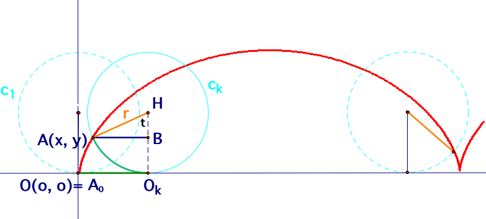
LetŐs
take a look of the diagram above that a cycloid has been placed on the x-y
plane. Let the point A, with the coordinates of (x, y), be an arbitrary point
on the first blue circle c1. When time = 0, let the point A locates on the
origin and denote it as A0. Also we define a parameter t which is the angle that the blue
circle has moved through along the x-axis. Within a single hump, t ranges from 0 to 2![]() in radians
measure. As defined earlier, the radius of the blue circle is denoted as r. In other words, the angle t is the angle through which the radius r turns as the blue circle rolls to a
new position.
in radians
measure. As defined earlier, the radius of the blue circle is denoted as r. In other words, the angle t is the angle through which the radius r turns as the blue circle rolls to a
new position.
At
time = k, the first blue circle c1 has moved forward to the second
blue circle ckŐs location. The x term of the point A can be
expressed as the horizontal distance from the center of the circle ck
to origin minus the horizontal distance, AB, of the point A to the center of
the circle ck. The horizontal distance from the center of the circle
ck to origin, which is the length of OOk, equals the arc
AOk = 2![]() r*(t/2
r*(t/2![]() ) = tr
according to the formula of the perimeter for a circle. Furthermore, AB = r*sin(t)
since sin(t) = AB/r. So x = tr - r sin(t) = r(t - sin(t)).
) = tr
according to the formula of the perimeter for a circle. Furthermore, AB = r*sin(t)
since sin(t) = AB/r. So x = tr - r sin(t) = r(t - sin(t)).
Now,
consider the vertical part, which is the y term of the point A. At time k, when
the blue circle is in the circle ckÔs position, y equals vertical
distance of the center ck to origin minus the distance from the
center of the circle ck to the point B. If we denote the center of
the circle ck as H, then the description above can be written as y =
HOk - HB = r - r*cos(t) since cos(t) = HB/r. Therefore, y = r -
r*cos(t) = r(1 - cos(t)).
The mathematical
expression of a cycloid is
x = r(t - sin(t))
y = r(1 - cos(t))
Here
I am going to use the Graphing Calculator to explore the cycloid equation
derived earlier.
First, let the radius r = 1:
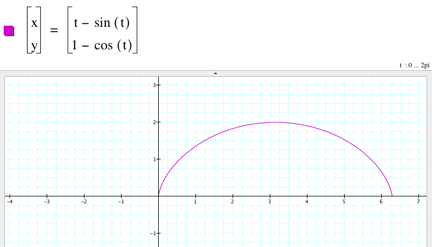
As we can see from the graph, when t ranges between 0
and 2![]() , the equation
forms a single hump just like the one we got in the previous section.
Therefore, as t increases by the multiple of 2
, the equation
forms a single hump just like the one we got in the previous section.
Therefore, as t increases by the multiple of 2![]() , we got the
ordinary cycloid of r = d = 1 like the one below.
, we got the
ordinary cycloid of r = d = 1 like the one below.
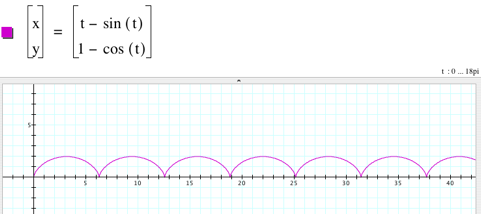
WhatŐs the difference between cycloids with different
r values, say 2, 3, or ½ ?
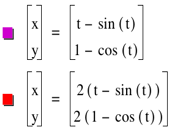
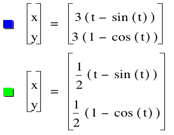
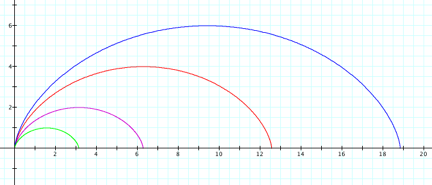
As we can see from above, the different values of r
allow the cycloids to expand or to shrink. However, they donŐt affect the
cycles of the cycloids. That is to say, when t is in the range of 0 and 2![]() , each cycloid
above completes one cycle (one hump) no matter which r-value they have.
, each cycloid
above completes one cycle (one hump) no matter which r-value they have.
What if r is negative numbers?
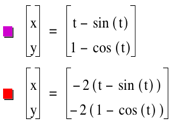
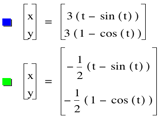

It is obvious that by changing the sign of r the
cycloid can be located in any of the four quadrants.